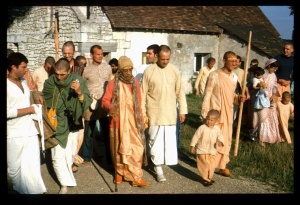CC Adi 17.281 (1975): Difference between revisions
(Vanibot #0027: CCMirror - Mirror CC's 1996 edition to form a basis for 1975) |
(Vanibot #0020: VersionCompareLinker - added a link to the Version Compare feature) |
||
| Line 2: | Line 2: | ||
<div style="float:left">'''[[Sri Caitanya-caritamrta (1975)|Śrī Caitanya-caritāmṛta (1975)]] - [[CC Adi (1975)|Ādi-līlā]] - [[CC Adi 17 (1975)|Chapter 17: The Pastimes of Lord Caitanya Mahāprabhu in His Youth]]'''</div> | <div style="float:left">'''[[Sri Caitanya-caritamrta (1975)|Śrī Caitanya-caritāmṛta (1975)]] - [[CC Adi (1975)|Ādi-līlā]] - [[CC Adi 17 (1975)|Chapter 17: The Pastimes of Lord Caitanya Mahāprabhu in His Youth]]'''</div> | ||
<div style="float:right">[[File:Go-previous.png|link=CC Adi 17.280 (1975)|Ādi-līlā 17.280]] '''[[CC Adi 17.280 (1975)|Ādi-līlā 17.280]] - [[CC Adi 17.282 (1975)|Ādi-līlā 17.282]]''' [[File:Go-next.png|link=CC Adi 17.282 (1975)|Ādi-līlā 17.282]]</div> | <div style="float:right">[[File:Go-previous.png|link=CC Adi 17.280 (1975)|Ādi-līlā 17.280]] '''[[CC Adi 17.280 (1975)|Ādi-līlā 17.280]] - [[CC Adi 17.282 (1975)|Ādi-līlā 17.282]]''' [[File:Go-next.png|link=CC Adi 17.282 (1975)|Ādi-līlā 17.282]]</div> | ||
{{CompareVersions|CC|Adi 17.281|CC 1975|CC 1996}} | |||
{{RandomImage}} | {{RandomImage}} | ||
==== TEXT 281 ==== | ==== TEXT 281 ==== | ||
<div class="verse"> | <div class="verse"> | ||
:gopīnāṁ paśupendra-nandana-juṣo bhāvasya kas tāṁ | :gopīnāṁ paśupendra-nandana-juṣo bhāvasya kas tāṁ krtī | ||
:vijñātuṁ kṣamate durūha-padavī-sañcāriṇaḥ prakriyām | :vijñātuṁ kṣamate durūha-padavī-sañcāriṇaḥ prakriyām | ||
:āviṣkurvati vaiṣṇavīm api tanuṁ tasmin bhujair jiṣṇubhir | :āviṣkurvati vaiṣṇavīm api tanuṁ tasmin bhujair jiṣṇubhir | ||
| Line 20: | Line 19: | ||
<div class="synonyms"> | <div class="synonyms"> | ||
gopīnām—of the gopīs; paśupa-indra-nandana-juṣaḥ—of the service of the son of | gopīnām—of the gopīs; paśupa-indra-nandana-juṣaḥ—of the service of the son of Vraja's King, Mahārāja Nanda; bhāvasya—ecstatic; kaḥ—what; tām—that; kṛtī—learned man; vijñātum—to understand; kṣamate—is able; durūha—very difficult to understand; padavī—the position; sañcāriṇaḥ—which provokes; prakriyām—activity; āviṣkurvati—He manifests; vaiṣṇavīm—of Viṣṇu; api—certainly; tanum—the body; tasmin—in that; bhujaiḥ—with arms; jiṣṇubhiḥ—very beautiful; yāsām—of whom (the gopīs); hanta—alas; caturbhiḥ—four; adbhuta—wonderfully; rucim—beautiful; rāga-udayaḥ—the evoking of ecstatic feelings; kuñcati—cripples. | ||
</div> | </div> | ||
| Line 27: | Line 26: | ||
<div class="translation"> | <div class="translation"> | ||
"Once Lord Śrī Kṛṣṇa playfully manifested Himself as Nārāyaṇa, with four victorious hands and a very beautiful form. When the gopīs saw this exalted form, however, their ecstatic feelings were crippledī. A learned scholar, therefore, cannot understand the gopīs' ecstatic feelings, which are firmly fixed upon the original form of Lord Kṛṣṇa as the son of Nanda Mahārāja. The wonderful feelings of the gopīs in ecstatic parama-rasa with Kṛṣṇa constitute the greatest mystery in spiritual life."" | |||
</div> | </div> | ||
Latest revision as of 16:28, 26 January 2020

A.C. Bhaktivedanta Swami Prabhupada
TEXT 281
- gopīnāṁ paśupendra-nandana-juṣo bhāvasya kas tāṁ krtī
- vijñātuṁ kṣamate durūha-padavī-sañcāriṇaḥ prakriyām
- āviṣkurvati vaiṣṇavīm api tanuṁ tasmin bhujair jiṣṇubhir
- yāsāṁ hanta caturbhir adbhuta-ruciṁ rāgodayaḥ kuñcati
SYNONYMS
gopīnām—of the gopīs; paśupa-indra-nandana-juṣaḥ—of the service of the son of Vraja's King, Mahārāja Nanda; bhāvasya—ecstatic; kaḥ—what; tām—that; kṛtī—learned man; vijñātum—to understand; kṣamate—is able; durūha—very difficult to understand; padavī—the position; sañcāriṇaḥ—which provokes; prakriyām—activity; āviṣkurvati—He manifests; vaiṣṇavīm—of Viṣṇu; api—certainly; tanum—the body; tasmin—in that; bhujaiḥ—with arms; jiṣṇubhiḥ—very beautiful; yāsām—of whom (the gopīs); hanta—alas; caturbhiḥ—four; adbhuta—wonderfully; rucim—beautiful; rāga-udayaḥ—the evoking of ecstatic feelings; kuñcati—cripples.
TRANSLATION
"Once Lord Śrī Kṛṣṇa playfully manifested Himself as Nārāyaṇa, with four victorious hands and a very beautiful form. When the gopīs saw this exalted form, however, their ecstatic feelings were crippledī. A learned scholar, therefore, cannot understand the gopīs' ecstatic feelings, which are firmly fixed upon the original form of Lord Kṛṣṇa as the son of Nanda Mahārāja. The wonderful feelings of the gopīs in ecstatic parama-rasa with Kṛṣṇa constitute the greatest mystery in spiritual life.""
PURPORT
This is a quotation from the Lalita-mādhava (6.54), by Śrīla Rūpa Gosvāmī.